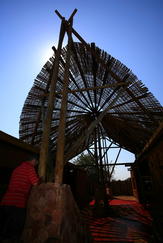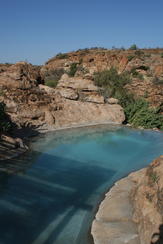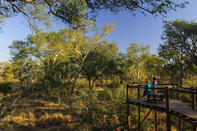Four Rest Camps

This is Mapungubwe’s party piece. The accommodation is fantastic! All four rest camps are newly built, and the results are spectacular. No boring thatch rondawels here.
Each camp has its own design and feel, and the architects have tried to make sure that the construction materials fit neatly into the surrounding landscape.
This sympathetic interplay between the built environment and the natural environment is really one of the most successful examples of eco-architecture I’ve seen.
Inside the buildings, there is a refreshing attention to detail, and each camp has its own unique personality. All accommodation is strictly self-catering and the park does not have any restaurants or shops at this stage.
Leokwe Camp

This is the main rest camp, and is close to the Confluence View Site and the Treetop Hide. It is situated at the foot of a stunning sandstone valley, filled with red, eroded rocks that rise up around the camp. The design is based on a traditional Venda village, and the rough, circular, ochre walls of the cottages blend in perfectly with the surroundings.
The rest camp has a small swimming pool, cut into the rocks, a central braai area and a sundeck. A small shop has been built, but it was not yet open when I visited. I’ve been told it stock a couple of basics, like charcoal, sweeties and cold drinks, but don’t expect a wide selection.
Limpopo Forest Tented Camp
Situated in the middle of the thick riverine forest in the western part of the reserve, this camp is located close to the Maloutswa bird hide. Although you can’t see the river, the tented camp is home to hundreds of birds and other arboreal creatures. The surroundings are serene and edifying – perfect for birding.Vhembe Wilderness Camp

This is probably my favourite camp. It is situated in the wilds of the eastern part of the park, far away from everything. There are only four cabins in the camp, built on the edge of a ridge that overlooks a spacious valley filled with trees. There is no electricity and the camp uses solar power for lighting.
Each cabin consists of two single beds, a toilet, shower and an open deck with a great view. The fittings inside the cabins are simple but in excellent taste. There is a communal kitchen, dining area and lapa that is shared between the 4 cabins. There is also a tiny paddling pool, hidden away in the rocks above the camp.
Tshugulu Lodge

This is the luxury option. Tshugulu is a rather imposing guest lodge with top-end finishes and big, cushy pillows. The lodge is located in the western part of the park, tucked into a nook between several tall boulders. These vibrant red rocks are certainly striking.
Tshugulu has the largest swimming pool in the park, and offers guests a comfortable night’s sleep in stone-clad suites with spacious bathrooms. The units all have air-conditioning and rather elegant mosquito nets.
There are 6 rooms, and the lodge can accommodate a total of 12 people. A fully equipped kitchen is available, with cavernous walk-in fridges.
Self Catering Mapungubwe Accommodation
All the facilities at Mapungubwe are self-catering. And I do mean self-catering. Mapungubwe National Park does have a shop where you can buy basic supplies, but it is better to come completely prepared, so if you run out of eggs, you don’t have to drive 70 ks to either Alldays or Mussina to get some more.
For day visitors, there is a restaurant that offers a la carte breakfasts and light meals, and there are also picnic areas where you can stop and braai. You can rent gas braais at the picnic area, but you won’t be able to buy wood. Reception at the main gate has a fridge with water, fruit juice and soft drinks. All the overnight accommodation is well geared for self-catering.
Each room has a fully equipped kitchen with all the mod-cons: microwave, toaster, fridge, stove, oven etc. Cutlery, crockery, pots and pans are all included. All you have to bring is the food, drinks and firewood.
The tap water in the park is potable (that means you can drink it), but it does taste a little funny. If you have a delicate tummy, it’s probably a good idea to bring along lots of mineral water, or beer as the case may be.
By David Fleminger